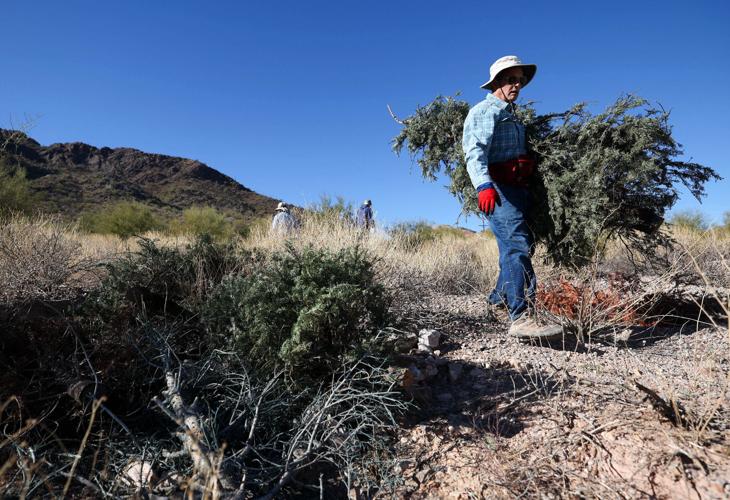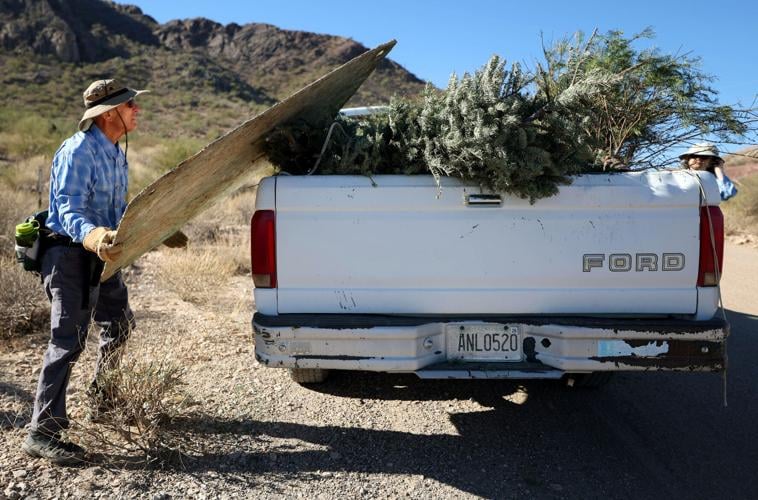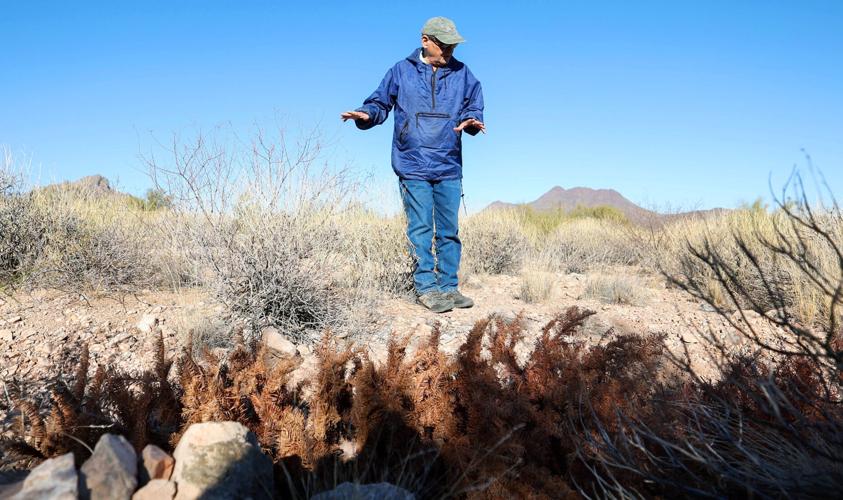It’s beginning to look a lot like Christmas in the desert at the western edge of Avra Valley.
For the third January in a row, volunteer caretakers at the Waterman Restoration Site are using recycled holiday trees to curb erosion and collect moisture in this reclaimed corner of Ironwood Forest National Monument.
This year’s crop of about 30 Christmas trees was packed into a large ditch left by an earlier downpour, so future rainfall will remain on site to spur the growth of native desert plants.
“It’s kind of like healing a wound,” said John Scheuring, who is heading up the work as conservation chair for the Tucson-based Arizona Native Plant Society.
For almost two decades, this 18-acre patch of public land was used and abused by the owner of a nearby mining claim, who was evicted by federal authorities in the late 1990s but left behind a scarred wasteland covered in invasive buffelgrass.

Andrew Gourevitch, a volunteer with the Arizona Native Plant Society, places a recycled Christmas tree to plug an erosion ditch at the Waterman Restoration Interpretive Site. This year about 30 Christmas trees were packed into a large ditch left by an earlier downpour so future rainfall will remain on site to spur the growth of native desert plants.
Today, the desert is slowly making its way back, thanks to the relentless work of hundreds of volunteers from the Native Plant Society and other nonprofit groups, backed by the federal Bureau of Land Management.
Once barren land is now dotted with young palo verde and ironwood trees, which were planted as seeds and have grown to as much as 12 feet tall.
BLM officials designated the area as an interpretive site on the north side of the Waterman Mountains in 2022 to recognize that ongoing rehabilitation effort.
The first batch of recycled Christmas trees was hauled to the property in January of 2023 to plug a headcut channel carved by a powerful late-monsoon storm the previous year.
Scheuring said it took 75 trees laid end to end to fill the entire ditch, which was more than 2 feet deep and about 500 feet long.

Ed Nigl, a volunteer with Arizona Native Plant Society, uncovers a truck bed full of recycled Christmas trees at the Waterman Restoration Interpretive Site, a reclaimed corner of
Ironwood Forest National Monument.
Volunteers returned to the site with pickaxes that September, once the trees were dry and brittle, to compact them into the channel and secure them in place with rocks.
Another 55 recycled trees were brought in to reline the same ditch and plug several shorter erosion channels in January 2024.
“It has to be done carefully. You can’t just willy-nilly throw them on,” Scheuring said. “It’s not rocket science, but it’s very targeted.”
All of the repurposed evergreens were provided by the town of Oro Valley, which holds an annual Christmas tree recycling drive with the help of the Kiwanis Club.
If left unchecked, Scheuring said, erosion ditches can grow large enough to effectively drain a sizable part of the landscape, robbing nearby plants of the water they need to survive. Fewer plants then leads to even more erosion, further compounding the problem, he said.
Restoration of the Waterman site first began about 20 years ago, when the Grand Canyon Chapter of the Sierra Club recruited volunteers from the Phoenix area to attack what conservationists called “the mother of all buffelgrass patches.”
The fast-growing perennial from Africa and Asia was introduced to Arizona in the 1930s to feed livestock and control erosion. It has since exploded into a major threat to the desert ecosystem by crowding out native plants and fueling once-rare wildfires that kill saguaros, palo verdes and other iconic local species.
It took close to a decade to bring buffelgrass under control at the Waterman site through a sustained herbicide campaign led by Scheuring. Then, the focus shifted to making the disturbed land welcoming to native growth again.
The idea to fill the erosion channels with recycled plant material came from Scheuring and fellow Native Plant Society member Dennis LeBlond, who Scheuring described as “our water-harvesting guru.” He said they first tested the method about 15 years ago at a different site as a way to protect archaeological resources from eroding out of the soil, “and by golly it worked.”

John Scheuring, conservation chairman for the Arizona and Tucson Native Plant Societies, explains why volunteers place Christmas trees to plug erosion ditches at the Waterman Restoration Interpretive Site.
LeBlond was also the brains behind other innovative techniques — many of them pioneered centuries ago by Indigenous desert dwellers — to capture moisture and help spur native plant growth on parts of the property once buried in mine waste or cleared for roads, building pads and a dirt airstrip.
To retain more rainwater, compacted earth was churned and dimpled or armored with small dams built from a single layer of rocks. Tree trimmings collected offsite were dragged onto bare patches of ground to provide cover and trap moisture for native seedlings.
So far, these restoration hacks appear to be working, and so do the Christmas trees.
Scheuring said more than 4 inches of rain fell on the Waterman Restoration Site between Dec. 1, 2023, and Feb. 1, 2024, but no water flowed from the mouth of the largest of the tree-lined ditches.
“The big bonus is to get that moisture to stay on site,” he said. “If you don’t try, don’t know.”






